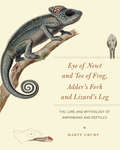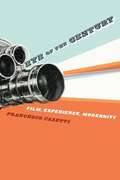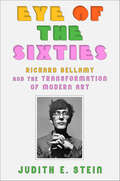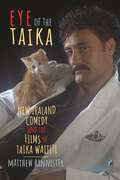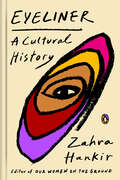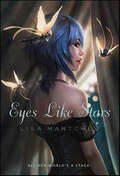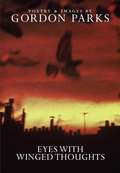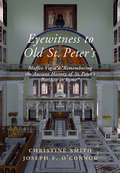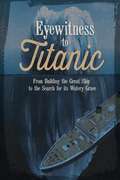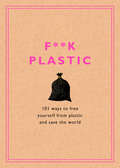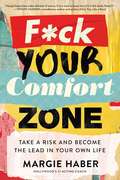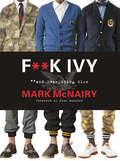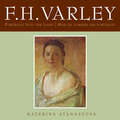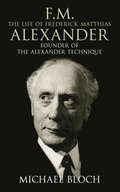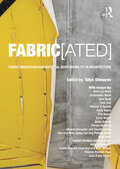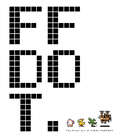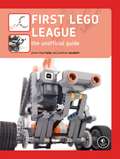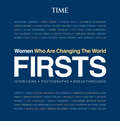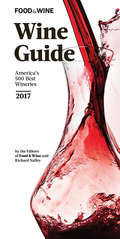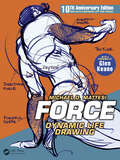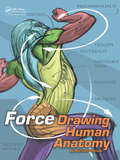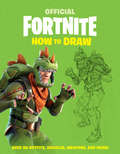- Table View
- List View
Eye of Newt and Toe of Frog, Adder's Fork and Lizard's Leg: The Lore and Mythology of Amphibians and Reptiles
by Marty CrumpFrom celebrated herpetologist and science writer Marty Crump, a beautifully illustrated exploration of the interlinked stories of herp folklore, natural history, and conservation. Frogs are worshipped for bringing nourishing rains, but blamed for devastating floods. Turtles are admired for their wisdom and longevity, but ridiculed for their sluggish and cowardly behavior. Snakes are respected for their ability to heal and restore life, but despised as symbols of evil. Lizards are revered as beneficent guardian spirits, but feared as the Devil himself. In this ode to toads and snakes, newts and tuatara, crocodiles and tortoises, herpetologist and science writer Marty Crump explores folklore across the world and throughout time. From creation myths to trickster tales; from associations with fertility and rebirth to fire and rain; and from the use of herps in folk medicines and magic, as food, pets, and gods, to their roles in literature, visual art, music, and dance, Crump reveals both our love and hatred of amphibians and reptiles—and their perceived power. In a world where we keep home terrariums at the same time that we battle invasive cane toads, and where public attitudes often dictate that the cute and cuddly receive conservation priority over the slimy and venomous, she shows how our complex and conflicting perceptions threaten the conservation of these ecologically vital animals. Sumptuously illustrated, Eye of Newt and Toe of Frog, Adder’s Fork and Lizard’s Leg is a beautiful and enthralling brew of natural history and folklore, sobering science and humor, that leaves us with one irrefutable lesson: love herps. Warts, scales, and all.
Eye of the Century: Film, Experience, Modernity
by Francesco CasettiIn this brilliant book, acclaimed film scholar Francesco Casetti examines film's nature and role in the twentieth century, an age obsessed with immediacy, worried about newness, eager for nearness and transparency, and torn apart by conflict. In its time, cinema negotiated the different needs of modernity, compared and united conflicting stimuli, and provided answers for everydayness. Film cultivated a personal gaze, intimately tied to the emergence of point of view, but also able to restore the immediacy of the real; a complex gaze, in which reality and imagination were combined; a piercing gaze, achieved by machine, and yet deeply anthropomorphic; an excited gaze, rich in perceptive stimuli, but also attentive to the spectator's orientation; and an immersive gaze, which gave the impression of being inside the seen world while also maintaining a sense of distance. Each of these gazes combined two different qualities and balanced them, resulting in a synthesis that strived to bring about true compromises without ever sacrificing the complexity of contradiction. As Casetti demonstrates, film proposed a vision that, in making opposites permeable, modeled itself on an oxymoronic principle, and is therefore the key to understanding the modern experience.
Eye of the Century: Film, Experience, Modernity (Film and Culture Series)
by Francesco CasettiIs it true that film in the twentieth century experimented with vision more than any other art form? And what visions did it privilege? In this brilliant book, acclaimed film scholar Francesco Casetti situates the cinematic experience within discourses of twentieth-century modernity. He suggests that film defined a unique gaze, not only because it recorded many of the century's most important events, but also because it determined the manner in which they were received.Casetti begins by examining film's nature as a medium in an age obsessed with immediacy, nearness, and accessibility. He considers the myths and rituals cinema constructed on the screen and in the theater and how they provided new images and behaviors that responded to emerging concerns, ideas, and social orders. Film also succeeded in negotiating the different needs of modernity, comparing and uniting conflicting stimuli, providing answers in a world torn apart by conflict, and satisfying a desire for everydayness, as well as lightness, in people's lives. The ability to communicate, the power to inform, and the capacity to negotiate-these are the three factors that defined film's function and outlook and made the medium a relevant and vital art form of its time.So what kind of gaze did film create? Film cultivated a personal gaze, intimately tied to the emergence of point of view, but also able to restore the immediacy of the real; a complex gaze, in which reality and imagination were combined; a piercing gaze, achieved by machine, and yet deeply anthropomorphic; an excited gaze, rich in perceptive stimuli, but also attentive to the spectator's orientation; and an immersive gaze, which gave the impression of being inside the seen world while also maintaining a sense of distance. Each of these gazes combined two different qualities and balanced them. The result was an ever inventive synthesis that strived to bring about true compromises without ever sacrificing the complexity of contradiction. As Casetti demonstrates, film proposed a vision that, in making opposites permeable, modeled itself on an oxymoronic principle. In this sense, film is the key to reading and understanding the modern experience.
Eye of the Sixties: Richard Bellamy and the Transformation of Modern Art
by Judith E. SteinIn 1959, Richard Bellamy was a witty, poetry-loving beatnik on the fringe of the New York art world who was drawn to artists impatient for change. By 1965, he was representing Mark di Suvero, was the first to show Andy Warhol’s pop art, and pioneered the practice of “off-site” exhibitions and introduced the new genre of installation art. As a dealer, he helped discover and champion many of the innovative successors to the abstract expressionists, including Claes Oldenburg, James Rosenquist, Donald Judd, Dan Flavin, Walter De Maria, and many others. The founder and director of the fabled Green Gallery on Fifty-Seventh Street, Bellamy thrived on the energy of the sixties. With the covert support of America’s first celebrity art collectors, Robert and Ethel Scull, Bellamy gained his footing just as pop art, minimalism, and conceptual art were taking hold and the art world was becoming a playground for millionaires. Yet as an eccentric impresario dogged by alcohol and uninterested in profits or posterity, Bellamy rarely did more than show the work he loved. As fellow dealers such as Leo Castelli and Sidney Janis capitalized on the stars he helped find, Bellamy slowly slid into obscurity, becoming the quiet man in oversize glasses in the corner of the room, a knowing and mischievous smile on his face.Born to an American father and a Chinese mother in a Cincinnati suburb, Bellamy moved to New York in his twenties and made a life for himself between the Beat orbits of Provincetown and white-glove events like the Guggenheim’s opening gala. No matter the scene, he was always considered “one of us,” partying with Norman Mailer, befriending Diane Arbus and Yoko Ono, and hosting or performing in historic Happenings. From his early days at the Hansa Gallery to his time at the Green to his later life as a private dealer, Bellamy had his finger on the pulse of the culture. Based on decades of research and on hundreds of interviews with Bellamy’s artists, friends, colleagues, and lovers, Judith E. Stein’s Eye of the Sixties rescues the legacy of the elusive art dealer and tells the story of a counterculture that became the mainstream. A tale of money, taste, loyalty, and luck, Richard Bellamy’s life is a remarkable window into the art of the twentieth century and the making of a generation’s aesthetic.--"Bellamy had an understanding of art and a very fine sense of discovery. There was nobody like him, I think. I certainly consider myself his pupil." --Leo Castelli
Eye of the Taika: New Zealand Comedy and the Films of Taika Waititi (Contemporary Approaches to Film and Media Series)
by Matthew BannisterEye of the Taika: New Zealand Comedy and the Films of Taika Waititi is the first book-length study of comic film director and media celebrity Taika Waititi. Author Matthew Bannister analyses Waititi’s feature films and places his other works and performances—short films, TV series, advertisements, music videos, and media appearances—in the fabric of popular culture. The book’s thesis is that Waititi’s playful comic style draws on an ironic reading of NZ identity as Antipodean camp, a style which reflects NZ’s historic status as colonial underdog. The first four chapters of Eye of the Taika explore Waititi’s early life and career, the history of New Zealand and its film industry, the history of local comedy and its undervaluation in favor of more "serious" art, and ethnicity in New Zealand comedy. Bannister then focuses on Waititi’s films, beginning with Eagle vs Shark (2007) and its place in "New Geek Cinema," despite being an outsider even in this realm. Bannister uses Boy (2010) to address the "comedian comedy," arguing that Waititi is a comedic entertainer before being a director. With What We Do in The Shadows (2014), Bannister explores Waititi’s use of the vampire as the archetypal immigrant struggling to fit into mainstream society, under the guise of a mockumentary. Waititi’s Hunt for the Wilderpeople (2016), Bannister argues, is a family-friendly, rural-based romp that plays on and ironizes aspects of Aotearoa/New Zealand identity. Thor: Ragnarok (2017) launched Waititi into the Hollywood realm, while introducing a Polynesian perspective on Western superhero ideology. Finally, Bannister addresses Jojo Rabbit (2019) as an "anti-hate satire" and questions its quality versus its topicality and timeliness in Hollywood. By viewing Waititi’s career and filmography as a series of pranks, Bannister identifies Waititi’s playful balance between dominant art worlds and emergent postcolonial innovations, New Zealand national identity and indigenous Aotearoan (and Jewish) roots, and masculinity and androgyny. Eye of the Taika is intended for film scholars and film lovers alike.
Eyeing the Flash
by Peter FentonThe year is 1963, the setting small-town Michigan. Pete Fenton is just another well-mannered math student until he meets Jackie Barron, a teenage grifter who introduces him to the carnival underworld -- and lures him with the cons, the double-dealing, and, most of all, the easy money. The memoir of a shy middle-class kid turned first-class huckster, Eyeing the Flash is highly unorthodox, and utterly compelling.
Eyeliner: A Cultural History
by Zahra HankirA New York Times Book Review Editors' Choice Pick&“Cosmetic, tool of rebellion, status signifier: Eyeliner has been all these and more. Moving through millenniums and across civilizations, Hankir gives the makeup its eye-opening due.&” —The New York Times Book Review&“An impressive, rigorously researched, winding path through centuries and over continents.&” —NPR.org&“I loved Eyeliner. Hankir approaches her subject with dedicated curiosity, humility, and humor, blending anthropology, travel writing, memoir and history. A treat.&” —Kassia St. Clair, author of The Secret Lives of ColorFrom the acclaimed editor of Our Women on the Ground comes a dazzling exploration of the intersections of beauty and power around the globe, told through the lens of an iconic cosmeticFrom the distant past to the present, with fingers and felt-tipped pens, metallic powders and gel pots, humans have been drawn to lining their eyes. The aesthetic trademark of figures ranging from Nefertiti to Amy Winehouse, eyeliner is one of our most enduring cosmetic tools; ancient royals and Gen Z beauty influencers alike would attest to its uniquely transformative power. It is undeniably fun—yet it is also far from frivolous.Seen through Zahra Hankir&’s (kohl-lined) eyes, this ubiquitous but seldom-examined product becomes a portal to history, proof both of the stunning variety among cultures across time and space and of our shared humanity. Through intimate reporting and conversations—with nomads in Chad, geishas in Japan, dancers in India, drag queens in New York, and more—Eyeliner embraces the rich history and significance of its namesake, especially among communities of color. What emerges is an unexpectedly moving portrait of a tool that, in various corners of the globe, can signal religious devotion, attract potential partners, ward off evil forces, shield eyes from the sun, transform faces into fantasies, and communicate volumes without saying a word.Delightful, surprising, and utterly absorbing, Eyeliner is a fascinating tour through streets, stages, and bedrooms around the world, and a thought-provoking reclamation of a key piece of our collective history.
Eyes Beyond The Horizon
by Eleanor G. Bowman Susan F. TitusStory of the Far East Broadcasting Company's shortwave radio ministry
Eyes Like Stars (Theatre Illuminata)
by Lisa MantchevThe fantastic first novel in Lisa Mantchev's Theatre Illuminata trilogyWelcome to the Théâtre Illuminata, where the characters of every play ever written can be found behind the curtain. The actors are bound to the Théâtre by The Book, an ancient and magical tome of scripts. Bertie is not one of the actors, but they are her family. And she is about to lose them all because The Book has been threatened, and along with it the Théâtre. It's the only home Bertie has ever known, and she has to find a way to save it. But first, there's the small problem of two handsome men, both vying for her attention. Nate, a dashing pirate who will do anything to protect Bertie, and Ariel, a seductive air spirit. The course of true love never did run smooth. . . .With Eyes LIke Stars, Lisa Mantchev has written a debut novel that is dramatic, romantic, and witty, with an irresistible and irreverent cast of characters who are sure to enchant the audience.
Eyes with Winged Thoughts: Poems and Photographs
by Gordon ParksIn Eyes with Winged Thoughts, the forty-four photographs and fifty-eight poems, reflecting on his long and extraordinary life, offer a rare glimpse of his thoughts and feelings about everything from romantic love to the Iraq war and the passing of Pope John Paul II. He has done it all. Gordon Parks's life is an astonishing litany of firsts: in the 1940s he was the first African-American photographer to work for the Farm Security Administration and for Vogue and Life magazines; in the 1960s he would become the first African-American director of a major motion picture. A dominating figure in contemporary American culture, he is an artist of uncompromising vision and creativity. In 2002 Parks received the Jackie Robinson Foundation Lifetime Achievement Award and was inducted into the International Photography Hall of Fame, just the latest in a series of honors that began when he received a prestigious Julius Rosenwald Fellowship in 1941 and which now includes an Emmy, a National Medal of the Arts, and over fifty honorary doctorates. Now in his nineties, he could easily rest on his laurels, but the luminous photographs on display in Eyes with Winged Thoughts and the poems -- some meditative and lyrical, some raw with emotion about the war in Iraq and the tragedy of the tsunami -- show that he is still a true American Renaissance man.
Eyewitness to Old St Peter's: A Study of Maffeo Vegio's 'Remembering the Ancient History of St. Peter's Basilica in Rome,' with Translation and a Digital Reconstruction of the Church
by Christine Smith Joseph F. O'Connor Matffeo VegioOld St Peter's Basilica in Rome stood for over eleven centuries until it was demolished to make room for today's church on the same Vatican site. Its last eyewitness, Maffeo Vegio, explained to the Roman hierarchy how revival of the papacy, whose prestige after the exile to Avignon had been diminished, was inseparable from a renewed awareness of the primacy of Peter's Church. To make his case, Vegio wrote a history founded on credible written and visual evidence. The text guides us through the building's true story in its material reality, undistorted by medieval guides. This was its living memory and a visualization of the continuity of Roman history into modern times. This volume makes available the first complete English translation of Vegio's text. Accompanied by full-color digital reconstructions of the Basilica as it appeared in Vegio's day.
Eyewitness to Titanic: From Building the Great Ship to the Search for Its Watery Grave
by Terri Dougherty Sean Stewart Price Sean McCollumView the story of the doomed ship Titanic through the eyes of those who knew it best. Builders, crew members, passengers, and explorers who discovered the wreck each have their own perspectives. Feel the pride of builders as they put the final touches on the grand staircase and the deep sadness of survivors who left loved ones behind. It's the story of the Titanic like you've never heard it before.
F**k Plastic: 101 Ways to Free Yourself from Plastic and Save the World
by Rodale SustainabilityThe Zero-Waste Guide to Life!Is the thought of the 51 trillion pieces of plastic in our oceans keeping you up at night? Don't panic! The war on plastic has begun and you can help. In this book you'll find 101 little things you as an individual can do to avoid single-use plastics and help save the world. You'll find sweet and simple ideas like carrying around your own cutlery, getting ice cream in a cone instead of a cup, and buying loose doughnuts or pastries for snacks instead of packaged sweets. Plus, you'll find 101 simple ways to cut plastic from:-FOOD AND DRINK: freeze fresh veggies rather than buying frozen ones, and buy beeswax wrap instead clingfilm-AROUND THE HOUSE: buy bars of soap instead of hand dispensers and swap scourers for natural cloths-YOUR LIFESTYLE: how to throw a plastic-free party and find good plastic-free make-upWith easy, no-nonsense steps for cutting plastic out of your everyday life, this is the perfect gift for anyone ready to start fighting the war on plastic. These easy nudges will guide you to change your habits bit by bit so that cutting out plastics becomes second nature.
F*ck Your Comfort Zone: TAKE A RISK AND BECOME THE LEAD IN YOUR OWN LIFE
by MARGIE HABERAre you stuck in your comfort zone? In your relationships, in your work, and in your life? What has it done for you lately? I thought so. It&’s time to f*ck your comfort zone. Margie Haber will gently and compassionately guide you out of your comfort zone and into a life of bravery, risk-taking, and being the best version of yourself. With Margie&’s help, you will learn how to transform your fear into personal power and approach life with empathy, humor, and curiosity. It will change everything. Whether in the intimate setting of her acting-intensive classes, in front of hundreds of corporate clients, or in this book, Margie teaches you how to happily live in the unknown and find the courage to be the lead in your own life. "Margie helped me make all kinds of moves. If you want to know how, it&’s in this book. Read it!" —Tiffany Haddish, comedienne, author, and actress (Girls Trip, Like a Boss) "I F*CKING LOVE THIS BOOK! It made me feel brave, resourceful, and, most important, creatively inspired. This book is a no-nonsense guide to living a new life, one where you get to be the lead. I recommend it to anyone who needs a dose of &‘F*ck it&’ in their lives. I certainly do.&” —Lisa Rinna, Actress, Author, Television Personality &“Life begins outside your comfort zone. In Margie&’s class, I always felt like that. This book will make you feel like a new person too—like nothing can stop you. Enjoy!&” —Toni Garrn, Model, Actress, Humanitarian "I was defined by perfectionism. I was afraid to be imperfect. There was no room for mistakes or vulnerability until I met Margie Haber. She gave me permission to be human.&” —Haddis Tadesse, Director, Bill and Melinda Gates Foundation &“Depression was my dark friend. Getting out of my comfort zone was my being willing to say goodbye to him. I wish I had F*ck Your Comfort Zone when I was younger. Margie always tells it like it is! I highly recommend it.&” —Rick Springfield, Grammy Award-Winning Musician, Actor, Author
F--k Ivy and Everything Else
by Mark McnairyThe renowned designer's views on dressing and behaving well: Ivy League meets street, sartorial rules are made and broken in this must-have style guide for traditionalists and hipsters alike, filled with Mark McNairy's humorous, sometimes snarky, spot-on observations. With a Foreword by Nick Wooster.Supported by a powerful cult following of dedicated, fashion-forward men around the globe, designer Mark McNairy has risen from an under-the-radar favorite to a driving force in contemporary style. His collection of menswear and footwear, Mark McNairy New Amsterdam, is defined by a strong sense of sartorial history with an eye fixed on the future; a unique style that reflects the designer's vast knowledge of American and English tailoring tradition and complete dedication to craftsmanship and his insistence upon messing it up a bit.With McNairy, irreverence rules, and in this definitive book, his fresh take on traditional menswear is displayed in full force. At once a style guide that provides invaluable tips for today's men, it is also, like his clothing and accessories, a witty riff on the Ivy League look.Showcasing a mix of vintage fashion and film images that reference traditional menswear and style icons like Steve McQueen and Clint Eastwood; examples of streetwear and McNairy's clothing; and advertising and pop culture references, F--k Ivy and Everything Else is a visual treat from spread to spread, packed with solid sartorial advice and cheeky humor.
F.H. Varley
by Katerina AtanassovaFrederick Horsman Varley was unique among the members of the Group of Seven. One of the greatest Canadian portraitists of the twentieth century, he is an intriguing example of an artist who, despite his fame as a portrait painter, remains better known for his landscapes. This is due mainly to his position as one of the founding members of the Group of Seven and their deliberate attempt to raise awareness of our national identity by depicting the Canadian landscape. Even though many public collections across the country, including the National Gallery of Canada, the Art Gallery of Ontario, and the Vancouver Art Gallery, display some of Varley’s best-known portraits, these works do not easily fit into the conventional mould of the Group of Seven. Nearly four decades after his death, Varley’s portraits are still not fully acknowledged. The release of this beautifully illustrated bilingual volume coincides with the opening of an unprecedented exhibition of his portraiture.
F.M.: Founder of the Alexander Technique
by Michael BlochThe Alexander Technique is a method of muscular re-education, which has become standard training for actors, dancers and singers, and is practised for health reasons all over the world. Its founder, Frederick Matthias Alexander (1869-1955), was an Australian actor who stumbled upon it in the 1890s after studying himself in mirrors to discover why he had lost his voice. He realised that most people suffered from the same postural defects he had noticed in himself, and that this explained much of what went wrong with them. F.M. (as he was known) came to London in 1904 and became enormously successful. During the First World War he practised in America with equal success, converting the American philosopher John Dewey to his cause. He wrote four books (all still in print), and his supporters included Aldous Huxley, George Bernard Shaw and Stafford Cripps. He was, however, a difficult and argumentative man who made enemies. Towards the end of his life he embarked on a libel action against the South African government, which had accused him of charlatanism. He won, and went on practising and propagating his technique until his death aged 86.
FABRIC[ated]: Fabric Innovation and Material Responsibility in Architecture
by Tolya StonorovFABRIC[ated] examines fabric as a catalyst for innovation, reflection, change and transformation in architecture. This book explores the ways in which research and development of fabric can, and historically has, influenced and revolutionized architecture, teaching and design. Responsive, flexible, impermanent, fluid and adaptive—fabric interacts with, and influences architecture, offering innovative solutions and increased material responsibility. Foundation and theory chapters establish clear precedent and futures for fabric’s position in architectural discourse. The case study section examines 14 international projects through three different threads: Veiling, Compression and Tension. Case studies include a diverse range of projects from the HiLo unit at Nest and CAST’s fabric formed concrete projects to a discussion of the impact of fabric on SO-IL and Kennedy Violich Architect’s professional work, demonstrating new and fresh methods for addressing sustainability and social justice through the use of fabric in architecture. Through the work of the many authors of this book, we see fabric as drape, skin, veil, mold, concept and inspiration. Fabric, in its broadest definition, is an important and innovative material in the development of socially conscious architecture. Offering readers pedagogical and practical models for international projects highlighting fabric’s use in architecture, this book will appeal to the novice and the expert, architecture students and practitioners alike.
FF DOT: The Pixel Art of Final Fantasy
by Square EnixA hardcover volume that showcases the intriguing evolution of pixel art from the Final Fantasy series!Containing detailed sprite sheets that showcase the pixel composition of Final Fantasy's beloved characters, maps of Final Fantasy's most popular highlighting tools used by the developers, and a special interview with Kazuko Shibuya, the character pixel artist for the Final Fantasy series, FF Dot is a one of a kind product that immerses readers into an iconic aspect of the Final Fantasy experience. Dark Horse Books is proud to collaborate with Square Enix to bring fans FF Dot: The Pixel Art of Final Fantasy, translated into English for the first time. This localization of the original Japanese publication holds nearly 300 pages of colorful pixel art, and is an invaluable addition to any Final Fantasy fan's collection.
FIRST LEGO League: The Unofficial Guide
by James Floyd Kelly Jonathan Daudelin<P>FIRST LEGO® League (FLL) is an international program for kids ages 9 to 14 that combines a hands-on, interactive robotics program and research presentation with a sports-like atmosphere. Authors James Floyd Kelly and Jonathan Daudelin—both participants in numerous FIRST LEGO League competitions—have teamed up to bring coaches, teachers, parents, and students an all-in-one guide to FLL. <P>Written for both rookie and experienced teams, FIRST LEGO League: The Unofficial Guide includes in-depth coverage of topics like team formation and organization, robot building and programming, and the basics of getting involved with FLL. Before the authors delve into the specifics of robot and team building, they reveal the fascinating history of the FIRST organization and the sometimes puzzling structure of the FLL competition. Using a combination of real-life stories and candid commentary from actual FLL teams, as well as recollections of their own experiences, they offer an abundance of helpful guidance and dependable building and programming examples. <P>FIRST LEGO League: The Unofficial Guide explores the complex workings and structure of the FLL competition, including its four key components: Robot Game, Technical Interview, Project, and Teamwork. You’ll learn how to: <br>–Organize, recruit, and manage a team <br>–Find equipment, mentors, and funding <br>–Design, build, and program winning robots <br>–Tackle each of the four FLL components <br>—from Robot Game to Teamwork–Use strategies and techniques from FLL masters to increase your scores <P>No matter what your role in the FLL competition, FIRST LEGO League: The Unofficial Guide will make you a better competitor, builder, designer, and team member. The only ingredient you need to add is your competitive spirit!
FIRSTS: Women Who Are Changing the World
by The Editors of TIME MagazineThis groundbreaking collection profiles nearly 50 women across a range of endeavors: business, politics, science, technology, sports, entertainment and more. A companion to TIME's multi-platform documentary, the book includes 15 first person deep-dives into the lives of influential women such as General Lori Robinson, the first woman to lead troops into combat, Kathryn Sullivan, the first woman to walk in space, and Aretha Franklin, the first woman inducted into the Rock and Roll Hall of Fame. Many others, including Oprah Winfrey, Madeline Albright, and Sheryl Sandburg offer their own personal reflections, thematic quotes and perspectives on balance, perseverance and strength.Each first-person piece or quote is accompanied by a distinctive portrait by photographer Luisa Dorr-set up and taken on her iPhone. Others included in this unforgettable volume: Serena Williams, Ellen Degeneres, Loretta Lynch, Shonda Rimes, Nancy Pelosi, Rita Moreno, Cindy Sherman and Mo'Ne Davis.With a stirring introduction by Nancy Gibbs, herself a pioneer as the first female editor of TIME magazine, this is an inspirational book for all women and men.
FOOD & WINE 2017 Wine Guide: America's 500 Best Wineries
by Richard Nalley The Editors of Food & WineAmerican wineries step up!The 2017 Food & Wine Wine Guide provides accessible expert reviews and recommendations of the top bottlings from 500 wineries across the United States. From established producers to exciting up-and-comers we uncork Pinot Noirs and Chardonnays, Cabernets and Merlots from California, the Pacific Northwest, across the Heartland and the East Coast.There is no better time for American wine and no better guide than the 2017 Food & Wine Guide!
FORCE: 10th Anniversary Edition (Force Drawing Series)
by Mike MattesiBring your artwork to life with the power of the FORCE! Watch, listen, and follow along as Mike Mattesi demonstrates the fundamental FORCE line and explains dynamic figure drawing techniques through 30 videos that are launched through the book's companion App. Packed with superb, powerfully drawn examples, the updated third edition of FORCE features an all-new section on the "FORCE blob," and dozens of fresh illustrations. Mike Mattesi’s 10th anniversary edition of FORCE will teach readers how to put thought and imagination to paper. Whether you are an illustrator, animator, comic book artist, or student, you'll learn to use rhythm, shape, and line to bring out the life in any subject. The 10th Anniversary Edition contains numerous improvements. Around 30 videos are embedded within the book and accessible through the FORCE Drawing App. In the App, click on the image of the camera, point your mobile device’s camera at the page with the symbol, and then finally tap the video card image floating above the drawing to launch the video. Then sit back and watch the video that shows me creating that drawing and discussing my process. Many new drawings can be found within this edition and the addition of color now further clarifies the theory of FORCE. Key Features The unique, dynamic learning system that has helped thousands of artists enhance their figure drawing abilities Dozens of updated illustrations and all-new content, exclusive to the 3rd edition Select pages can be scanned by your smartphone or other device to pull up bonus video content, enhancing the learning process Companion App: Nearly 50 videos are available on the free FORCE Drawing companion app that can be downloaded through Google Play or the Apple App Store
FORCE: Drawing Human Anatomy (Force Drawing Series)
by Mike MattesiThe newest book in Michael Mattesi’s Force Drawing series takes movement to the next level. Force: Drawing Human Anatomy, explores the different facets of motion and the human body. As opposed to the memorization technique, Mattesi stresses the function of each body part and how gravity relative to different poses affects the aesthetics and form of muscle. The chapters are divided by the different parts of the body, thus allowing the reader to concentrate on mastery one body part at a time. Color coded images detail each muscle and their different angles. Special consideration is given to anatomy for animation, allowing the reader to create a character that is anatomically accurate in both stillness and motion. Key Features Detailed visual instruction includes colourful, step-by-step diagrams that allow you to easily follow the construction of an anatomically correct figure. Clearly organized and color coded per regions of the body's anatomy, a clarity of design for better reader understanding. Learn how anatomy is drawn and defined by the function of a pose. Visit the companion website for drawing demonstrations and further resources on anatomy.
FORTNITE (Official Fortnite Books)
by Epic GamesDraw your favorite Outfits, vehicles, weapons, and more with Epic Games' first official how to draw book, including tips to make your sketches as epic as your in-game achievements and featuring the authentic Fortnite holographic seal.Learn how to draw 35 of the game's most popular icons-including Outfits, weapons, building materials, and vehicles. In easy-to-follow stages, you'll go step-by-step from rough sketch to detailed finish.INCLUDES:16 iconic Outfits8 fearsome weaponsThe craziest in-game vehiclesDrawing guideTop art tips, including advanced shading and texture techniquesWhether you're a complete novice or an experienced artist, this book will inspire you to pick up a pencil and get sketching! LET'S GO!
